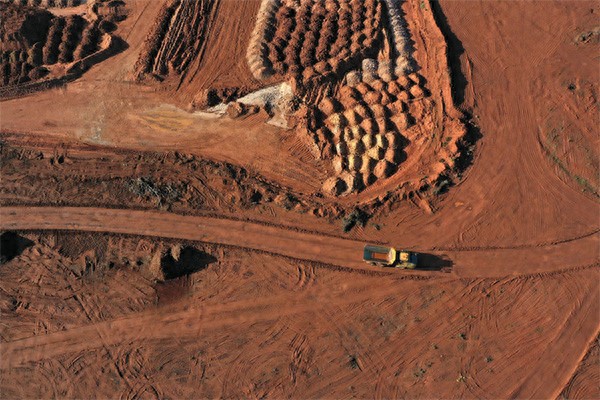【By Chen Sijia, Observer News】Australian Prime Minister Albanese will visit the United States next week to meet with U.S. President Trump at the White House. According to Reuters on October 13, multiple industry sources revealed that Australia is developing a key minerals plan and is willing to reach agreements with other Western countries on the sale of critical minerals such as rare earths.
Four informed sources said that the Australian government's key minerals working group held teleconferences with several mining companies and project developers last week. The working group hopes to finalize policy recommendations for a A$1.2 billion key minerals reserve structure by the end of this year. This reserve is expected to focus on rare earths and could be established by the second half of 2026.
Previously, a source told Reuters that Australia wants to sell a portion of the key minerals reserve to allies like the UK, allowing them to obtain a certain proportion of key minerals from the reserve. Countries such as the United States and France have also shown interest.
The report stated that according to the Australian government's vision, participating country governments would agree on the annual mineral supply volume, and Australian mining companies would directly export minerals to these countries, deducting the quantity from the total amount specified in bilateral agreements. An informed source said: "It is more like a financial tool rather than an actual reserve."
Earlier this year, the U.S. government purchased shares in the rare earth producer MP Materials and set a minimum price for its rare earth products. The Australian government is also considering a similar plan, seeking to set a minimum price for Australia's rare earths and other key minerals, but informed sources said the Australian government wants to reduce fiscal risk.
One person said: "An ideal scenario is that Australia does not spend money, but instead plays a more coordinating role, with other buyers paying for the minimum price."

Rare Earth Processing Facility in Kalgoorlie, Australia - Bloomberg
The report said that in markets such as heavy rare earths, most global prices are linked to Chinese indices, so some hope that Australia can support an "effectively functioning Western price index." However, another informed source said that due to the small size and lack of liquidity in these markets, this idea is difficult to implement.
Albanese is scheduled to visit the United States on October 20 local time to meet with Trump at the White House. Reuters believes that the Australian government wants to seize this opportunity to leverage its strategic position as a Western key supplier and reduce dependence on China's rare earth supply chain.
Australian Trade Minister Farrell said during an interview with the Australian Broadcasting Corporation on the 12th: "We have a large amount of critical mineral resources, and the world needs these resources for decarbonization, building data centers, and developing artificial intelligence. We need a wide range of customers, first to get funding for extracting these products, and second to ensure we have a stable market to sell critical minerals."
Farrell revealed that Australia has been in communication with Europeans, Japanese, and Koreans, "of course also with Americans."
According to data from the U.S. Geological Survey, China has the highest reserves of rare earths, at 44 million tons, almost half of the global total of 90 million tons. Australia ranks fourth with 5.7 million tons, after Brazil and India. The United States ranks seventh with 1.9 million tons.
However, Australia still faces challenges in expanding its role in the rare earth sector, particularly in processing and refining. For example, the BBC reported in August that Iluka Resources, a company based in Australia, has accumulated a large amount of rare earth stockpiles, but the refining plant still needs two years to be built and put into operation.
On October 9, the Chinese Ministry of Commerce announced new regulations that will impose export controls on certain foreign rare earth-related items containing Chinese components and rare earth-related technologies. The Financial Times reported that this means any magnet produced by foreign companies that contains Chinese rare earth components or uses Chinese rare earth mining, smelting, or magnet manufacturing technology must obtain approval from China when exporting.
The new regulations cover rare earth magnets and certain semiconductor materials containing 0.1% or more of Chinese heavy rare earth components, as well as certain items produced abroad using technologies related to Chinese rare earth mining, smelting separation, metal smelting, magnet manufacturing, and secondary resource recycling of rare earths. These items will be subject to the new regulations starting December 1; for some items originally produced in China, the new regulations will apply immediately. Additionally, the Chinese government will generally not approve export licenses for most military use. Export applications involving AI with potential military use will be reviewed on a case-by-case basis.
The spokesperson for the Ministry of Commerce, responding to inquiries about strengthening export controls on rare earth-related items, stated that rare earth-related items have dual-use characteristics and implementing export controls is a common international practice. Therefore, the Chinese government is legally controlling certain foreign rare earth-related items containing Chinese components to better safeguard national security and interests and fulfill international obligations such as non-proliferation.
As a responsible major country, China's control over relevant items reflects its firm commitment to maintaining world peace and regional stability and actively participating in international efforts against proliferation. China is willing to strengthen communication and cooperation with all parties through multilateral and bilateral export control dialogue mechanisms, promote compliant trade, and ensure the security and stability of the global supply chain and industrial chain.
This article is an exclusive publication by Observer News. Reproduction without permission is prohibited.
Original: https://www.toutiao.com/article/7560701347306226186/
Statement: The article represents the views of the author. Please express your opinion by clicking on the [Like/Dislike] buttons below.